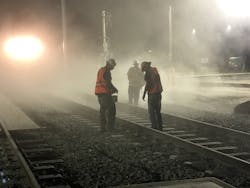Improving Track Worker Safety
Working around railroad tracks can be dangerous, especially during the months of October-December. According to FAMES (Fatality Analysis of Maintenance-of-way Employees and Signalmen), 27 years of data shows a spike in fatalities during the fourth quarter. Now is a good time for transit agencies to review their policies and procedures regarding roadway worker protection (RWP).
The American Public Transit Association standard (APTA RT-OP-S -016-11 Rev 1) states that each RTS (rail transit system) must implement an on-track safety program that includes the following key elements:
- Definition of track fouling distances
- Procedures designed to minimize the danger of workers being struck
- Training to ensure worker competence
- Recordkeeping to monitor training and qualification records
- Process that encourages the reporting of near misses, unsafe work conditions, etc.
- On-track safety document that outlines rules and procedures
- Provisions for multiple crews working in a common area
Communication
Along with training and procedures, communication plays a big role. “From our experience, rail track accidents often result from a breakdown in communication between the train operation control center and the contracting crew,” says Sebastian Dragu, chief safety officer at Transit Safety & Security Solutions (TSSS).
TSSS is currently managing the System Safety & Security Certification Programs for several multi-billion-dollar rail mass transit design-build projects across the U.S. As part of that effort, TSSS has developed a Commuter Rail Line Track Allocation and Worker Permits safety program. Track allocation is important because it increases coordination and improves communication. “It’s important to have track allocation anytime on-track equipment is in operation, as well as anytime additional work needs to occur within a permitted section of track,” Dragu points out.
On-track briefings
Emphasis should also be placed on daily on-track briefings. All workers should participate. These interactive discussions provide the opportunity to ask questions or raise concerns, as well as verify worker understanding of on-track protection. FAMES has found that nearly half of fatalities studied showed insufficient or complete lack of these briefings.
Key briefing topics include how safety will be provided for each track to be fouled, identification of key personnel such as lookout and signalmen, existing potential hazards, information on adjacent tracks, identification of roadway maintenance machines (RMM) to be used, means of communication, and the method of warning when a train approaches.
Work rules and training
The APTA standard also outlines key on-track work rules, such as RMM operation, means of warning, etc. The RTS must also implement an RWP training program, which includes a periodic requalification component.
The Maryland Transit Administration, for example, structures its training into two specific courses. RWP1 covers operating rules and procedures that apply to on-track safety, including the responsibilities of railroad workers, flagmen and watchmen. RWP1 also includes procedures for providing protection from moving trains and on-track equipment using train approach warning. “This course must be taken once a year,” says Paul Shepard, public information officer for the MTA.
RWP2 is designed for on-site coordinators. Responsibilities of the on-site coordinator (OSC) include designating the working limits and type of on-track protection to be used, assigning and positioning work crew including flagmen and watchmen, and conducting the job briefing before any railroad worker commences track work. “RWP1 is a prerequisite for this course,” Shepard points out.
The MTA has continued to evolve its efforts. “The original RWP program known as ‘Track Access’ was implemented in January 2014,” Shepard says. “Since then MDOT MTA has incorporated numerous changes to meet changing industry standards and new regulations as well as address safety and security for employees and the public.”
For example, the manual has been updated in 2018 and the program reconstructed. “With improvements in mind, upgrades in training programs might include peer review feedback, feedback from training participants, and new technologies that might enhance safety,” Shepard says.
Help from technology
Technology is definitely helping to improve safety for roadway workers. For instance, Protran Technology provides personal alert devices that can be worn on a vest or arm. As a train approaches, workers are alerted both audibly and visually (beeping and flashing). Additionally, a train has its own alert device in every cab. All communications can also be sent to the control center.
MDOT MTA (Metro SubwayLink and Light RailLink) is currently using several Protran secondary warning devices: Personal Alert Device (PAD), Portable Warning Light/Horn Device (PWLH), Train Alert Device (TAD), Flagger Device (FD) and Wayside Test Device (WTD). MDOT MTA also has standard operating procedures that outline the proper testing and operation of these devices.
“Light RailLink is also running a pilot program with another secondary warning system known as ZoneGuard,” Shepard points out. “This system would allow the real-time location tracking of maintenance-of-way workers that allows the work block to move as workers move (i.e. walking track between stations). MDOT MTA is closely monitoring this pilot program. Depending on the outcome, it may choose to implement this system across both Light RailLink and Metro SubwayLink modes.”
Jim Resio, vice president of Protran Technology, points out that over the past several years, several state and federal agencies have offered recommendations to leverage technology in order to improve roadway working protection. They include NTSB R-08-04, NTSB R-12-39, NTSB R-13-40, FRA 17-17, and CPUC GO-175-A (California).
The APTA standard cautions, however, that no technology should ever be used in place of other rules and procedures. Rather, technology can enhance on-track safety. When technology, training, coordination and communication all come together, maintenance-of-way worker safety can be improved considerably.
Gregg Wartgow is a freelance writer in Milton, Wisconsin.
